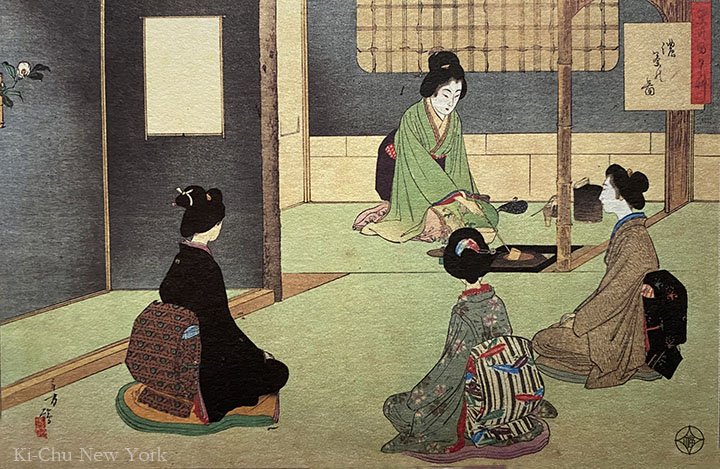The beginning of November a very important season for those of us who learn of the way of tea, known as the tea ceremony.
Around this time, we have a special tea gathering to celebrate the opening of the sunken hearth, known as Robiraki in Japanese. ‘Ro (炉)’ refers to the sunken hearth, a square pit set beneath the flooring, flush with the tatami. ‘Biraki'(開き)’means to open, so Robiraki literally marks the opening of the sunken hearth.
Ukiyo-e print (浮世絵) depicting the art of the tea ceremony by Toshitaka Mizuno (水野年方 1866-1903)
During winter, we use the sunken hearth instead of the floor brazier. The sunken hearth is an essential feature of a tea room and located almost centrally in the tea room, creating a warm atmosphere as everyone gathers around it. The Robiraki tea gathering signifies the initiation of a new cycle in the tea ceremony year. Almost two weeks ago, I attended a Robiraki tea gathering at our school, Urasenke Chanoyu Center, a delightful occasion where 25 people at each seat wore kimonos to celebrate and enjoy a bowl of matcha together.
There is another important thing in November. While the new season for green tea is in May, matcha's new season is in November. After harvesting fresh tea leaves, they age for half a year in a jar. In November, the jar is opened, and the aged tea leaves are ground using a stone mortar to make matcha powder. This marks the beginning of drinking new matcha for the season. When I visit Japan during this time, I always buy matcha for Robiraki at a small tea shop in Kyoto.
Speaking of matcha, a charming tea shop, Sorate opened in Soho just last month. The wonderful owner, Silvia, an Italian woman I met at a charity event for Ukraine last year, provided absolutely delicious matcha sourced from Uji, Kyoto.
On Sorate’s website, Silvia shares in her "A LOVE LETTER TO JAPAN":
“AND ITALY, MY HOME COUNTRY.
The idea for starting Sorate came to mind after a period when I felt physically and emotionally depleted by the pressures of life.
I decided to take a solo road trip through Japan to decompress. Making my way across the Japanese countryside, I discovered that the best way to keep my feet on the ground was to practice simple daily rituals. ….”
I knew she was learning the tea ceremony, but I was deeply moved when I saw a photo of her wearing a kimono and participating in a tea gathering held at Daitoku-ji Temple in Kyoto in the hot summer. I could feel her passion for Japanese culture and matcha.
Sorate has a very cozy and relaxing atmosphere, especially in the morning. I enjoy delicious matcha accompanied by the pleasant sounds of jazz and Italian language. I feel the vibrant essence of New York City, a cosmopolitan city, a true melting pot. Each person has their own roots, but one can embrace and love any culture. At our school, Urasenke Chanoyu Center, there is an American instructor who has been teaching for a very long time and is highly respected by all students, not only as a teacher but also as a person.
These days, I feel that the way of Japanese tea is not only for the Japanese people but that this spirit will be passed down to the next generation by those who truly love Japanese culture.

